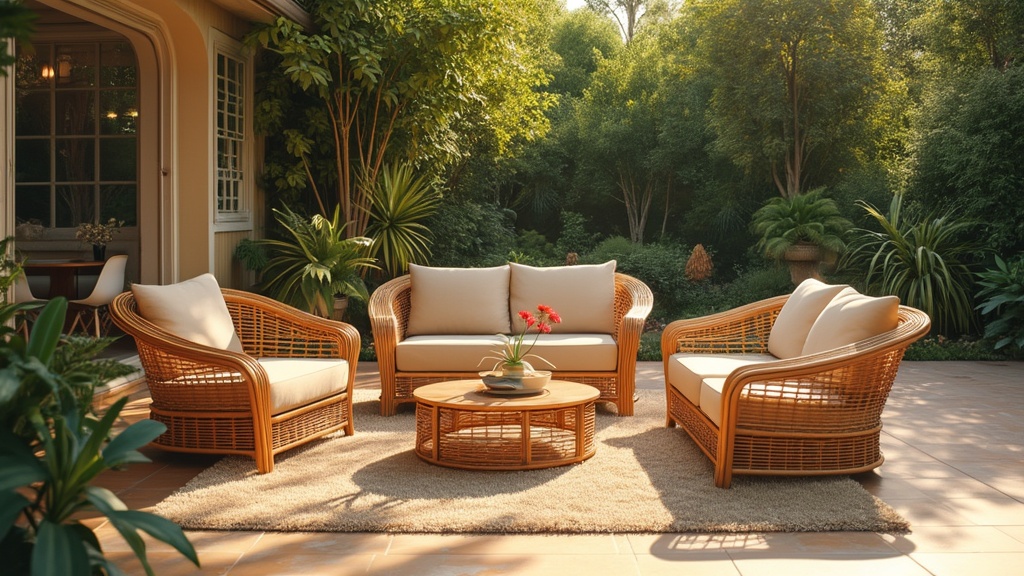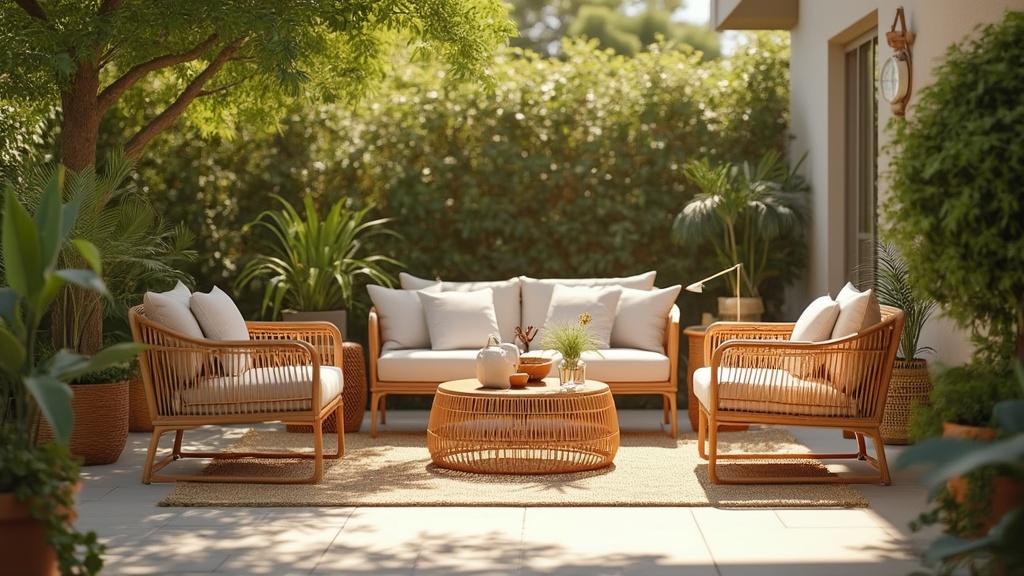Rattan furniture transforms interiors with a unique blend of style and functionality. This lightweight option enhances your decor while making it easy to rearrange your spaces.
Rattan’s rich texture and natural appeal not only bring warmth but also foster a sustainable approach to decorating.
Its eco-friendly materials resonate with today’s environmentally conscious consumers.
Inviting rattan pieces into your home can rejuvenate your atmosphere, creating an inviting and stylish environment. As you explore rattan options, consider how its handcrafted quality contributes to the aesthetic appeal of your living areas, making them both beautiful and functional.
Click here to learn more about: rattan furniture
Exploring Rattan Furniture Aesthetics
The charm of rattan can significantly enhance your living space while promoting sustainable production practices.
Rattan’s versatility allows it to seamlessly integrate with various decor styles, including bohemian and coastal themes. For instance, bohemian-style rattan chairs can add a relaxed vibe, while modern rattan coffee tables blend simplicity with utility.
Versatility in Design
Rattan’s craftsmanship tradition shines through in artisan furniture that combines form and function.
Look for pieces that exhibit both practicality and style:.
- Handmade baskets offer storage solutions without compromising aesthetics.
- Chair collections provide comfort and a stylish aesthetic.
- Table designs enhance your dining experience with unique charm.
These exceptional pieces not only fulfill everyday needs but also elevate your home decor, making rattan an impressive addition to any residence. Integrating rattan into your interior decor reflects ethical sourcing and a commitment to aesthetic appeal.

What Is Handmade Craftsmanship
Handmade craftsmanship embodies a longstanding tradition wherein artisans create products with meticulous attention to detail, adding personal touches that resonate with their cultural heritage. This type of artisan work not only showcases traditional techniques but also significantly enhances the local economy.
Purchases of handmade items provide direct support to artisans and their communities, fostering economic growth.
Interestingly, artisan markets often generate more income compared to mass-produced alternatives, benefiting local economies.
To effectively identify quality craftsmanship, examine features such as tight seams and intricate designs. The use of natural materials typically indicates a high standard of workmanship, ensuring unique pieces that stand out.
Benefits Of Ecofriendly Materials
Emphasizing the importance of ecofriendly materials highlights their role in sustainable design, which ultimately contributes to reducing environmental impact.
Making informed choices about ecofriendly materials can lead to substantial long-term cost savings as these durable materials often require less maintenance. For example, materials like bamboo and rattan not only demand less energy for production but are also sustainably sourced, enhancing their affordability.
To successfully source ecofriendly materials, it is advisable to connect with local suppliers and explore online retailers specializing in sustainable products.
Seek out certifications such as FSC (Forest Stewardship Council) to verify ethical sourcing and ensure quality assurance.
Handmade Craftsmanship and Ecofriendly Materials
- Handmade products often have a lower environmental footprint compared to mass-produced items, as they typically use less energy in production.
- Artisan markets can generate up to 50% more income for local economies than conventional retail options.
- Using ecofriendly materials can lead to a reduction in waste, as many sustainable materials are biodegradable or recyclable.
- Artisans who focus on quality craftsmanship often report higher customer satisfaction and repeat business, enhancing community ties.
Understanding British-inspired Design
The essence of British-inspired design is deeply rooted in its rich cultural history and diverse influences. Historical movements, particularly the Victorian era and the Arts & Crafts movement, have profoundly shaped the key characteristics of British aesthetics.
Notably, eclecticism emerges as a defining feature, where homes often showcase a mélange of styles across different periods, resulting in visually dynamic environments.
Color palettes typically embrace rich, earthy tones accompanied by lighter shades, which emanate warmth and comfort.
For modern spaces, consider incorporating quality materials such as wood and wool to enhance the tactile experience.
Here are some tips to help you incorporate British elements into your contemporary interiors:.
- Mix styles: Combine various periods and styles to create a unique atmosphere.
- Opt for artisan furniture: Invest in handcrafted pieces that reflect traditional craftsmanship.
- Include soft furnishings: Utilize textiles that add texture and warmth, such as plaid or floral patterns.
- Incorporate clever decor: Use decorative accents like vintage finds that tell a story.
By blending traditional elements with contemporary designs, such as stylish accent pieces and artisan furniture, you can authentically embrace British-inspired design.
How To Leverage Resale Opportunities
Resale opportunities present significant advantages within the furniture market, especially as trends evolve rapidly. Maintaining furniture in pristine condition is essential, as this practice can greatly enhance its resale value. High-quality pieces, particularly those showcasing handmade craftsmanship, often appreciate over time, drawing the interest of discerning buyers.
Regular upkeep, including cleaning and minor repairs, plays a critical role in effective resale preparation.
Documenting the provenance and condition of furniture can also make a substantial difference in its marketability. Here are some effective tips to prepare your items for resale:.
- Engage in quality assurance: Ensure each piece meets high standards for resale.
- Utilize high-resolution photography: Capture unique features to enhance appeal.
- Connect with online retailers: Foster partnerships with both brick-and-mortar stores and digital platforms.
- Highlight craftsmanship: Promote the artisan techniques and materials used in each item.
By expanding your market reach and ensuring that your carefully maintained furniture garners the attention it deserves, you can capitalize on lucrative resale opportunities.
| Design Elements | Resale Strategies |
|---|---|
| Eclectic mix of styles | Regular upkeep and minor repairs |
| Quality materials like wood and wool | High-resolution photography for listings |
| Artisan furniture with traditional craftsmanship | Highlighting craftsmanship and materials |
Navigating Licensing Requirements
Licensing requirements represent a fundamental aspect of operating within the rattan furniture industry. Local regulations can vastly differ, impacting business viability and legal compliance.
For example, states may impose unique laws on furniture sales, including material specifications.
Therefore, businesses must prioritize research into these essential regulations.
A practical step to start this process is to visit your local government’s business portal for industry-specific licensing information. Additional resources, like the Small Business Administration, can provide further guidance tailored to your needs.
Recognizing these requirements enhances sustainability and promotes legal integrity within your market reach.
The Importance Of Customer Satisfaction
Customer satisfaction significantly influences the success of rattan furniture businesses. High satisfaction rates can drive customer loyalty and generate positive word-of-mouth referrals.
Studies reveal that acquiring new customers can be five times more costly than retaining existing ones.
Thus, businesses should implement effective strategies to gather customer feedback.
Effective Feedback Collection
To gather valuable insights into customer experiences with your unique pieces, consider the following methods:.
- Post-Purchase Surveys: Distribute surveys after transactions to assess satisfaction levels.
- Social Media Engagement: Utilize platforms for real-time feedback, enabling quick understanding of customer perceptions.
- Review Requests: Encourage customers to leave reviews, which can highlight strengths and areas for improvement.
Prioritizing customer satisfaction fosters long-term relationships and enhances overall business performance in the competitive furniture marketplace.
Customer Satisfaction
- Customer satisfaction is linked to a 5-10% increase in repeat purchases.
- Companies with high customer satisfaction scores can see a 20% increase in revenue.
- Positive customer experiences can lead to a 50% increase in customer referrals.
- Businesses that prioritize customer feedback can improve their product offerings by up to 30%.
Maximizing Discounts With Bulk Orders
Unlocking the potential of bulk purchasing can drastically transform your budgeting and procurement strategies. Companies that incorporate bulk purchasing methods often experience significant reductions in overall costs.
When evaluating potential savings, it is worth noting that bulk orders can yield discounts ranging from 5% to 30%, depending on the industry.
Understanding the Savings
Suppliers usually provide tiered pricing based on order volume, which can further enhance savings.
Establishing routine purchasing habits with wholesale suppliers can cultivate long-term relationships, resulting in loyalty discounts.
Here are some key considerations for maximizing your savings:.
- Evaluate Order Volume: Assess your typical purchasing needs to determine the most beneficial volume for discounts.
- Build Supplier Relationships: Consistent orders can lead to better terms and discounts with your suppliers.
- Negotiate Effectively: Discuss potential discounts directly with suppliers, showcasing your commitment to a long-term partnership.
Negotiating Bulk Order Discounts
Negotiating directly with suppliers while emphasizing your commitment can help secure even better deals. Suppliers are often willing to offer additional discounts on container-load purchases or other large orders. Consider the following tips for effective negotiations:
- Research Competitive Pricing: Be informed about competitor pricing to leverage during negotiations.
- Showcase Loyalty: If you have consistently ordered from a supplier, highlight this history during negotiations.
- Discuss Payment Terms: Flexible payment options might encourage suppliers to provide additional discounts.
By adopting these strategies, bulk purchasing can become an essential tactic for maximizing savings, allowing businesses to optimize their procurement processes while enhancing overall efficiency. This approach not only strengthens supplier relationships but also improves budget management and financial forecasting capabilities.
Bulk Purchasing
- Bulk purchasing can lead to discounts of 5% to 30%, depending on the industry.
- Establishing routine purchasing habits with wholesale suppliers can result in loyalty discounts.
- Negotiating directly with suppliers can secure additional discounts on large orders.
- Consistent orders can lead to better terms and improved supplier relationships.



